November 2015
Kelly published a paper in the journal Psychoneuroendocrinology entitled Involvement of the oxytocin system in the bed nucleus of the stria terminalis in the sex-specific regulation of social recognition. Kelly, Remco, Alexa and undergrads Andrea Alonso (’15) and Marisa Immormino (’15) examined, for the first time, the link between oxytocin receptor expression and oxytocin release in a single brain region and revealing higher oxytocin receptor binding and higher oxytocin release during social recognition in male rats compared to female rats. These findings emphasize the importance of studying both sexes in order to fully understand how the oxytocin system modulates social behavior.
October 2015
Congratulations to Kelly for winning second place (out of 128 poster presenters) in the S4SN 2015 Annual Meeting Peoples Choice Poster Award!
October 2015
Nick, Alexa, Caroline, Remco, Brett, and Kelly presented their work at the Annual Meeting of the Society for Social Neuroscience (S4SN) and at the Annual Meeting of the Society for Neuroscience (SfN), in Chicago.
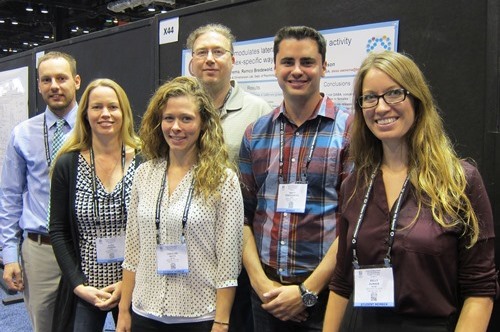
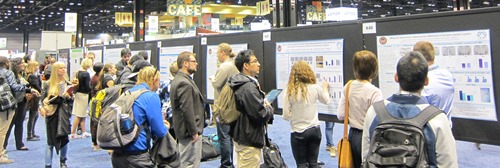
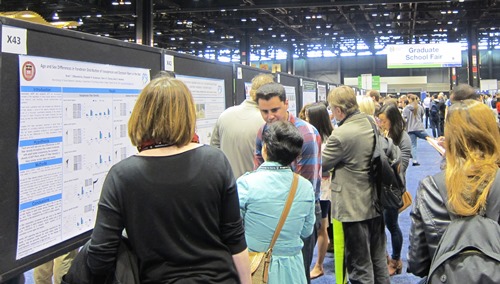
The SfN conference in Chicago brought together a community of 29,033 attendees from 78 countries, who interacted with 517 exhibiting companies, viewed 13,788 posters, and attended 839 sessions.

Chicago dinner with, clockwise, Sarah Kark (grad student in Elizabeth Kensinger’s lab at BC), Brett, Kelly, Remco, Jennifer Schiavo (former undergrad, now grad student in Rob Froemke’s lab at NYU), Alexa, Nick, and Caroline.
October 2015
Kelly and Alexa published a book chapter in Sex Differences in the Central Nervous System entitled “Presence and Absence of Sex Differences in Structure and Function of the Brain Oxytocin System: Implications for Understanding the Regulation of Social Behavior“. This book provides a comprehensive examination of the current state of sex differences research, from both basic science and clinical 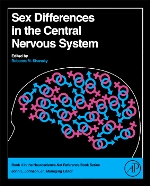 research perspectives. In our chapter we discuss the evidence showing sex differences, or lack thereof, in structure and function of oxytocin (OT) and the OT receptor in rodents and humans. We find that (i) the reported sex differences in the brain OT system are not ubiquitous, but appear to be highly species-specific and (ii) actions of the OT system on behavior and neuronal responses are often sex-specific, but do not necessarily correspond with sex differences in OT system parameters. Based on these findings, we propose that sex differences in the brain OT system depend on species-specific social organizations (i.e., mating, parental, and sociality systems) and discuss sex-specific actions of OT on behavior and neuronal responses in the context of differences in social organizations. Furthermore, OT may show promise in the treatment of social dysfunction in neuropsychiatric disorders, many of which show sex differences in prevalence and treatment responses. We therefore discuss recent advances and precautions of OT as a therapeutic agent in the treatment of social dysfunction in both men and women. Overall, we find that there is limited research investigating the effects of OT on behavior and brain responses in males and females in the same design, highlighting the need for comparative research, particularly if OT is to be used as a therapeutic agent in both sexes. Given the many studies indicating a role of the brain OT system in sex-specific regulation of social behavior, an important next step will be to investigate how these effects are mediated and how they relate to the presence or absence of sex differences in brain OT system parameters.
research perspectives. In our chapter we discuss the evidence showing sex differences, or lack thereof, in structure and function of oxytocin (OT) and the OT receptor in rodents and humans. We find that (i) the reported sex differences in the brain OT system are not ubiquitous, but appear to be highly species-specific and (ii) actions of the OT system on behavior and neuronal responses are often sex-specific, but do not necessarily correspond with sex differences in OT system parameters. Based on these findings, we propose that sex differences in the brain OT system depend on species-specific social organizations (i.e., mating, parental, and sociality systems) and discuss sex-specific actions of OT on behavior and neuronal responses in the context of differences in social organizations. Furthermore, OT may show promise in the treatment of social dysfunction in neuropsychiatric disorders, many of which show sex differences in prevalence and treatment responses. We therefore discuss recent advances and precautions of OT as a therapeutic agent in the treatment of social dysfunction in both men and women. Overall, we find that there is limited research investigating the effects of OT on behavior and brain responses in males and females in the same design, highlighting the need for comparative research, particularly if OT is to be used as a therapeutic agent in both sexes. Given the many studies indicating a role of the brain OT system in sex-specific regulation of social behavior, an important next step will be to investigate how these effects are mediated and how they relate to the presence or absence of sex differences in brain OT system parameters.
September 2015
Kelly, Caroline, Sara, Grace, Harry, and Nick presented their work during the poster session at the 15th Symposium of the Center for Neuroendocrine Studies, UMass Amherst.
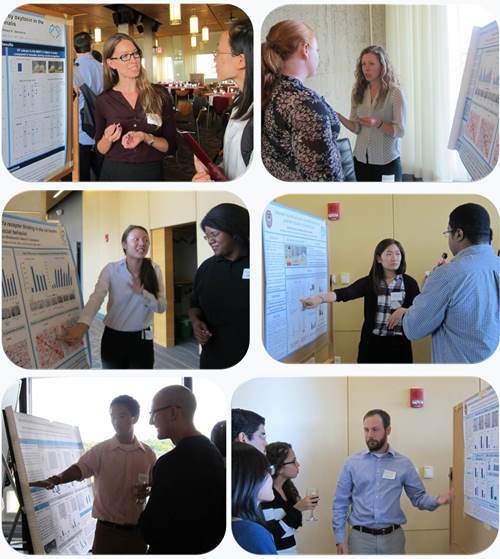
August 2015
Remco published a paper in the journal Neuroscience entitled Dynamic changes in extracellular release of GABA and glutamate in the lateral septum during social play behavior in juvenile rats: Implications for sex-specific regulation of social play behavior. Remco and co-authors Jennifer Schiavo, Marieke van der Hart, Michelle Verreij and Alexa Veenema demonstrate that the inhibitory neurotransmitter GABA released in the lateral septum facilitates social play behavior in both male and female juvenile rats, while the excitatory neurotransmitter glutamate released in the lateral septum facilitates social play behavior in females but not in males. Moreover, we found that the extracellular concentration of glutamate, but not GABA, in the lateral septum is higher in males than in females, indicating a sex difference in excitatory tone of the LS. Together, this suggests the involvement of glutamate in the sex-specific modulation of social play behavior. This complements our previous research demonstrating a role for vasopressin released in the lateral septum in the sex-specific regulation of social play behavior. A next step is to determine whether vasopressin interacts with glutamate to modulate social play behavior in sex-specific ways. A better understanding of how social play is regulated differently in both sexes is relevant given the impairments in social play behavior in autism, a neurodevelopmental disorder affecting more boys than girls.
August 2015
Kelly and Alexa are co-authors on a paper published in the journal Frontiers in Behavioral Neuroscience entitled Distinct BOLD activation profiles following central and peripheral oxytocin administration in awake rats. Using functional neuroimaging in awake adult male rats, leading author Craig Ferris, Kelly, Alexa, and other colleagues demonstrate that oxytocin induces distinct neuronal activation patterns depending on the route of administration, i.e., directly injected into the brain or injected in the periphery. This strongly suggests that peripheral oxytocin does not have direct access to the brain. This information is relevant given the current interest in using oxytocin to change brain activation which may help to alleviate social deficits in patients suffering from social disorders.
July 2015
Caroline published a paper in the Journal of Neuroendocrinology entitled Social novelty investigation in the juvenile rat: modulation by the mu-opioid system. Caroline and co-authors Kevin Wilkins, Jazmin Mogavero and Alexa Veenema show that social novelty-seeking in juvenile rats is facilitated by the opioid system in the brain, while dopamine, oxytocin, or vasopressin systems do not seem to be involved in mediating this behavior. This finding is relevant because impaired social novelty-seeking is characteristic for autistic children which may hamper their development of social skills. The next step will be to localize the effects of the opioid system to specific brain regions and neural circuits.
June 2015
Alexa gave a talk, and Brett, Caroline, Kelly, Nick, and Remco presented posters on their work at the Annual Meeting of the Society for Behavioral Neuroendocrinology which took place in Pacific Grove, California.
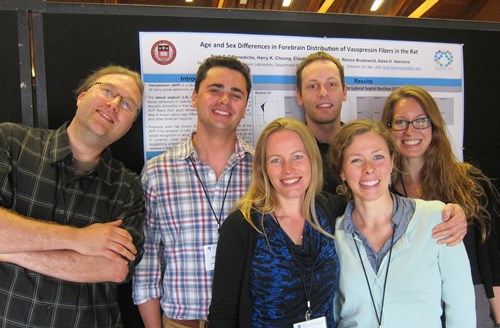


May 2015
Kelly Dumais and Alexa Veenema published a review paper in Frontiers in Neuroendocrinology entitled “Vasopressin and oxytocin receptor systems in the brain: Sex differences and sex-specific regulation of social behavior“. In this review paper, we discuss existing literature on sex differences in vasopressin (VP) and oxytocin (OT) and their receptors in rodents and humans, we include new data showing sex differences in V1a receptor binding in the rat brain, and we discuss the sex-specific regulation of social behaviors by the VP and OT systems. Overall, we find that there is a need for more comprehensive analysis of sex differences in these two systems and for understanding whether and how such sex differences underlie sex-specific regulation of social behavior by VP and OT systems. This knowledge may help to better understand how these neuropeptide systems are implicated in sex-specific regulation of healthy social behaviors as well as impaired social behaviors as seen in several neuropsychiatric disorders.
May 2015
Kelly, Caroline, and Nick gave talks about their research at the annual Graduate Research Day of the Department of Psychology at BC.
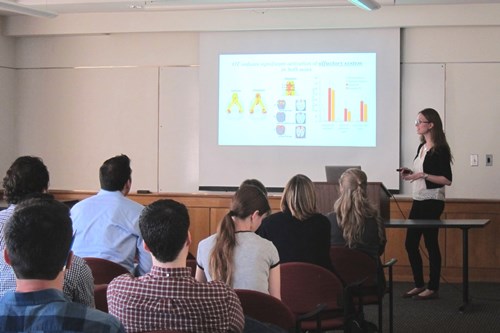
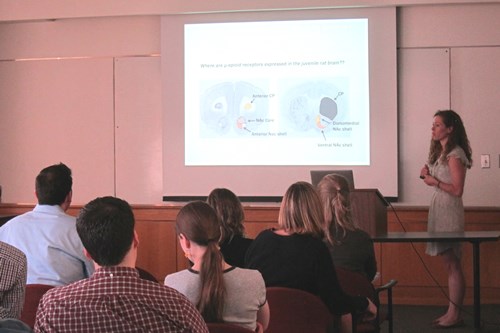
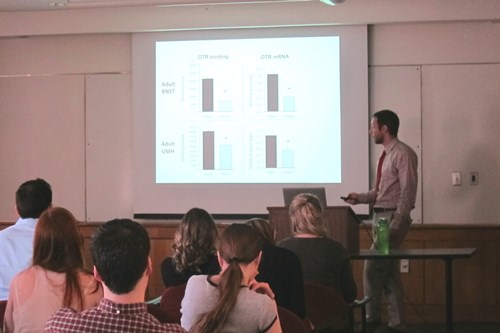
May 2015
Laura Newman was honored as Scholar of the College at Boston College.The Scholar of the College award is a designation awarded to exceptional students who have excelled academically in their undergraduate studies and who have done substantial independent scientific work of the highest quality in their senior year. Laura (middle) was supervised by Nick (right).
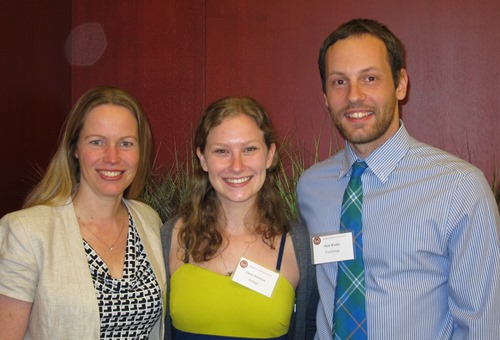
May 2015
Tessa Gillespie, Sara Li, Laura Newman, and Ari Ratnaseelan presented posters on their research projects at the annual Psychology Undergraduate Research Conference which took place at Boston College on May 4th.
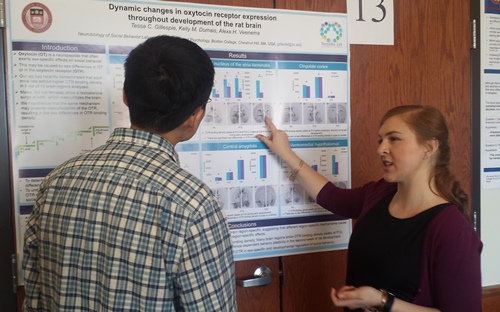
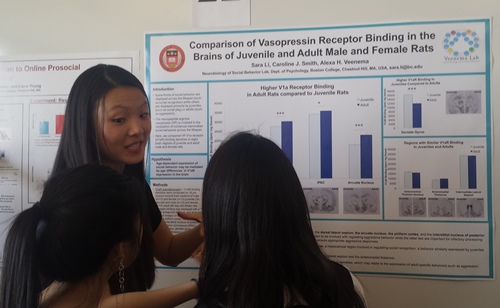
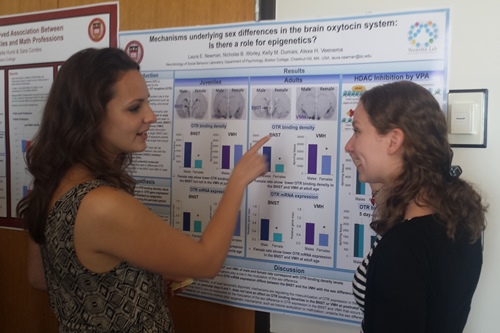
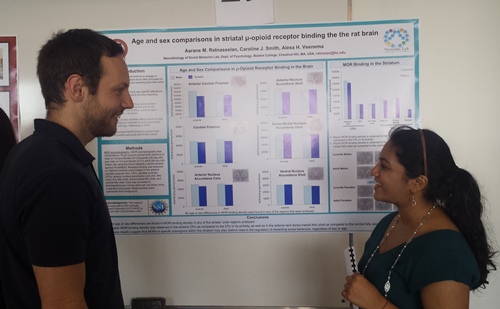
May 2015
Citations to Alexa’s publications reached 2500 on Google Scholar, which is 500 more than last year!
April 2015
Grace was awarded an Advanced Study Grant from BC to support her thesis research over the summer. Congrats Grace!
April 2015
Kelly was awarded a Dissertation Fellowship from the Graduate School of Arts & Sciences at BC. Congrats Kelly!
March 2015
Alexa gave a talk in a Symposium on “Comparative Aspects of Play in Humans and Rodents” at the Annual Meeting of the Eastern Psychological Association, which took place from March 5-7 in Philadelphia.
January 2015
Alexa gave a talk at the Winter Conference on Brain Research in a panel on “Vasopressin/Oxytocin and the Development of Mammalian Social Behavior”, organized by Elliott Albers (Georgia State University, second from left), with also as speakers Matt Paul (University at Buffalo; second from right) and Liz Hammock (Florida State University; far right). This conference took place in Big Sky, Montana, the biggest skiing in the USA. Go to Happenings for ski-photos.
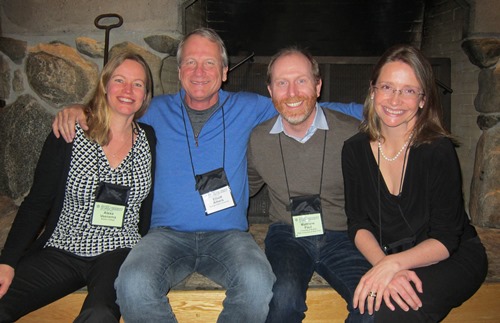
January 2015
Alexa has been elected board member of the Society for Social Neuroscience and will also serve on the program committee for the 2015 Annual Meeting of the Society for Social Neuroscience.
